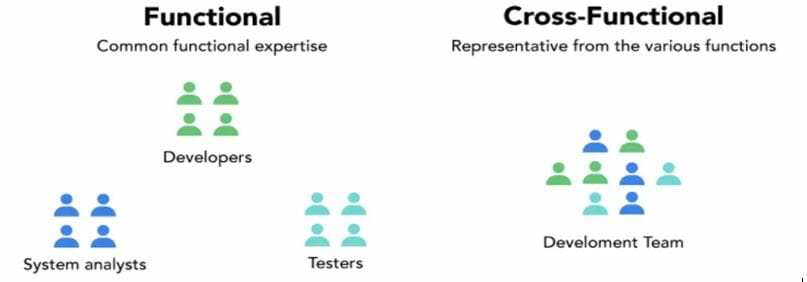Does your organization, customer or project turn to agile working methods like Scrum but you feel you’re still working in siloed teams? Let’s look at how Cross-Functional Teams can increase collaboration.
What do we mean by siloed teams?
Big organizations tend to divide employees into different departments or teams by their functions. From now on, let’s call it teams. This is traditionally, mainly because it’s easy to keep things.
I.e: Development, Testing, Architecture and so on are three different teams in an organizational chart.
When all of these three teams isolate themselves from each other and work alone rather than together, we call them siloed teams. Working like this reduces efficiency and productivity and can lead to challenging internal relationships.
But collaboration is important so how can we break down these siloes and encourage these teams to work together? Cross-Functional Teams.
What is a Cross-Functional Team?
Cross-Functional Teams refers to bringing members from different functional teams within an organization together as one team – i.e: Product Owner, Developers, Testers, Architects. All of these will now work together and towards a common goal.
A Cross-Functional Team should consist of 3-9 team members depending on the size of complexity of the project where the role of Product Owner and Scrum Master is excluded unless they are working on tasks within the Sprint Backlog.

Benefits of Cross-Functional Teams
1. Faster release cycles: Allowing members from different teams to share their best practices while working towards the common goal, makes them more agile and leveraging the knowledge from the entire team will increase the speed and productivity which transforms into more frequent release cycles.
2. Collaborative culture: Collaboration is promoted just by creating a Cross-Functional Team because it gathers members with unique skill sets and knowledge working together towards a common goal. Team members will engage one another and strengthen communication with people they haven’t had the chance to collaborate with before by discussing constructive feedback.
3. Employee engagement: Cross-Functional Teams can contribute with more satisfied employees due to the team connection particularly across the different teams and skill sets. And by putting everyone in a new environment with a mix of different people can boost their energy-level, creativeness and motivation.
4. Encourage members to learn new tools: By putting members into a cross-collaboration-environment, they will be exposed to new tools being used by other areas which can be adapted to increase productivity. This does not only apply for tools itself but can contain different processes, methodologies and values.
Conclusion
Cross-Functional Teams are becoming more and more popular especially within bigger organizations. It ensures that work and tasks do not get passed from silo to silo with the possibility of multiple bottlenecks.
From a personal perspective, I have been working in Cross-Functional Teams for multiple years and in different organizations and I have experienced a major change in productivity after changing from silo-based to Cross-Functional.
In addition, I like the idea that I want to push myself to learn new tools and get more knowledge on skills that my other team members hold to keep up the pace and continue to contribute to my team.

 English | EN
English | EN 